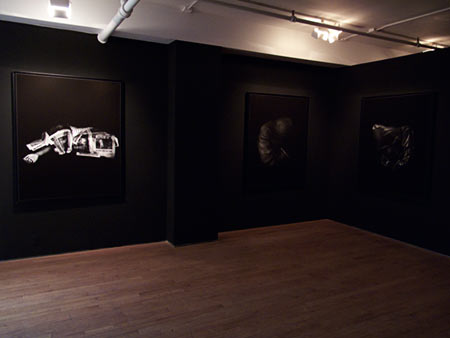Review: Touhami Ennadre at Priska C. Juschka Fine Art

On his website, under “My Approach”, Touhami Ennadre writes “The sense of my work is to reveal the essential, never to illustrate.” An exhibition at Priska C. Juschka Fine Art (on view until 2 Jan, 2010) provides an opportunity to see whether he succeeds in doing that. The show contains a selections of his photographs, hung in a dimly lit space.
Essentially, each of Ennadre’s photographs follows the same pattern: A detail - here faces and bodies - in a sea of blackness. The presentation of these photographs in the space struck me as a bit heavy-handed - it almost was as if the only thing missing was some dramatic music - and it left me wondering whether the viewers were actually given a real chance to experience (or maybe trust would be a better word) the photography: Too obvious is, well… too obvious.
That aside, I ended up with very mixed feelings about the show, in particular about the mixing of two very different bodies of work (there might be more than that, but all I remember are two). There are photographs of homeless people (these are in the “Under New York” category of the artist’s website) and photographs of people in nightclub or other obviously pleasurable situations (“Corps de Nuit”). The gallery’s press release acknowledges the obvious problem with this, stating that “Despite their palpably adverse conditions, Ennadre reveals an ambiance of beauty and intimacy - connecting the viewer to a population of social castaways by shooting them at closest range, ultimately subjecting his audience to their situation.” That is not what I took away from it.
Showing these different bodies of work right next to each other made me wonder whether I was not in fact dealing with something being illustrated instead of revealed. A photographer friend of mine, who I saw the show with, had the same reaction to the work.
That said, the photographs of homeless people photographically are quite strong - another marked contrast to the photographs of people in night clubs, which I found vacuous. So all in all, I was left a bit confused, and I thought that presenting the photographer’s work this way really took away from what it could have been, had the show focused on a single body of work.
PS: DLK’s review